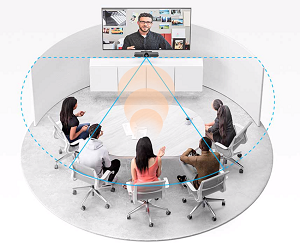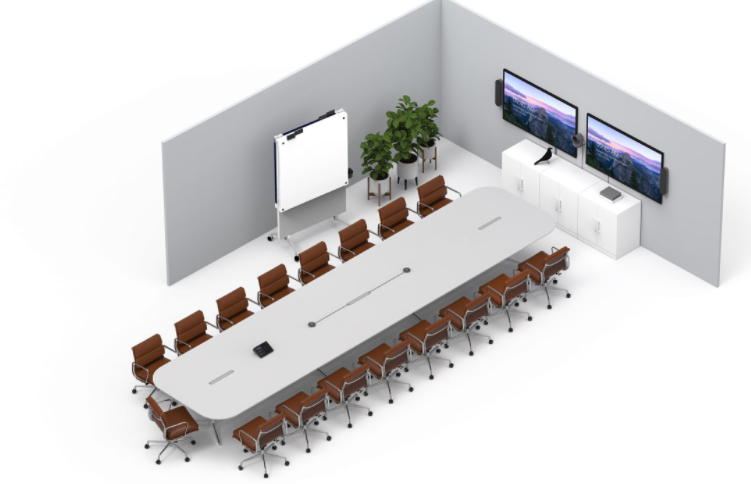You could be forgiven for assuming that making sure the Wi-Fi connection is good is the only thing you’d need to worry about when holding a virtual meeting, involving both office-based and remote delegates. If you’ve ever tried to hold a meeting for over 6 people present in the room and other delegates dialling in remotely, you may well have experienced difficulties with more than just the poor Wi-Fi connection.
We see common video conferencing mistakes from organisations believing that all they need for a conference of more than 6 people, is a laptop and a basic microphone, which doesn’t exactly make for the smoothest running of the meeting. So to save you the potential frustration of poor sound quality or the need for the delegates to huddle around a laptop, we’ve put together this list of the top 5 video conferencing mistakes and the ways in which you can prevent them so that you can enjoy a clear, smooth meeting. The solutions we suggest below will give you the freedom to invite as many delegates to take part as you would like with peace of mind that the quality of the sound and audio won’t be compromised.
Are you ready?
Here is a list of the top 5 commonly made mistakes when it comes to video conferencing technology;
1. Trying to use a webcam designed for a one-user PC
Using a webcam for a large meeting, which is only designed for a one-person PC, is going to limit the number of participants that will appear on the screen as it is not designed to capture the whole meeting room. Whilst it would probably be suitable for 2 or 3 people, more than this will reduce the quality of the interaction. If, as a last resort, only a webcam is available, it is important to place it at eye level so that participants can have a more natural interaction with remote participants.
The best recommendation we can give for a larger scale conference is to use a wide angled video conferencing camera. It is going to give a much clearer and more complete view of all the participants in the room so that the remote delegates can easily see everyone. It will also have a built-in high-performance microphone, or microphones which leads on nicely to the second mistake we often see happening.
2. Using a microphone not designed for video conferencing
Quite often, our customers come to us and say that the sound is particularly poor during their video conferences. The reason for this is that they are using the wrong kind of mic. In most cases, they will be using a ‘directional’ mic, rather than a ‘boundary’ mic. A boundary mic is used to record full room sound and picks up voice from a 360-degree range, rather than a directional mic, which only picks up sound from one specific area. They are designed to minimise background noise but a boundary mic is much more useful in a conference situation as it is assumed that the background noise would be minimal anyway. Gone are the days when you would need a mic to be placed in close proximity to the participants mouth. The technology has improved so much that the sound picked up from a boundary mic is super sensitive and clear.
3. Using an under-powered, desk-mounted projector
Whilst a desk-mounted projector certainly works for small meetings, it is not the best choice when it comes to larger meeting rooms. The reason being that most of the delegates at the back of the room will struggle to see the image. The projectors lumen count is often not high enough to allow participants to see the image, unless there is minimal light in the room. Let’s face it, who wants to have a meeting in the dark? Seeing your notes would be a challenge but if you’re anything like me, you’d probably struggle to stay awake as well! Even with the blinds pulled, an under-powered projector will struggle to produce the best image. If the lighting intensity is too low or too high, it can affect the mood of the participant which will impact on the interest they have on the presentation or meeting interaction. So it would be a better option to choose a projector which is ceiling mounted with at least 5000 lumens to ensure the best viewing experience of the participants.
4. The video conferencing solution is poorly installed
Cutting corners on a professional installation can undo any of the investment you have made on a first-class video conferencing solution. The reason being that an experienced installer will provide an inbuilt cable tidy and presentation unit within the meeting room solution. Without this, the cabling will be messy and therefore, very difficult to use. A skilled installer will ensure that the solution is seamless and will also look good, which is very important in a professional environment. It will also allow easy access to the necessary cables for the source technology used. So, if a presenter needs to use HDMI, USB or even VGA, they will not need to hunt around for this as it will be neatly presented in the cable unit.
5. Not using a complete video conferencing meeting room solution
Using a basic projector and screen is perfectly fine to use in a situation where all the delegates are present in the room. However, when delegates are dialling in to join the meeting remotely, using an online conferencing software such as Zoom or Teams, then the quality of the sound and image is hugely compromised for the online participants. Using a video conferencing solution which is designed specifically for the sole purpose of virtual conferences will hugely improve the quality of your meeting. For example, the Logitech Meetup solution comes with a fantastic wide-angle lens on the camera and great microphone pick up with optional extra boundary mic.
If you can avoid these 5 video conferencing mistakes, you will be significantly improving the user experience of your delegates, which will in turn, improve the effectiveness of the meeting and ultimately, the achievement of its objective.
If you see some room for improvement in your organisation’s meeting room solution, then please contact us with any questions or to book a free site survey.



